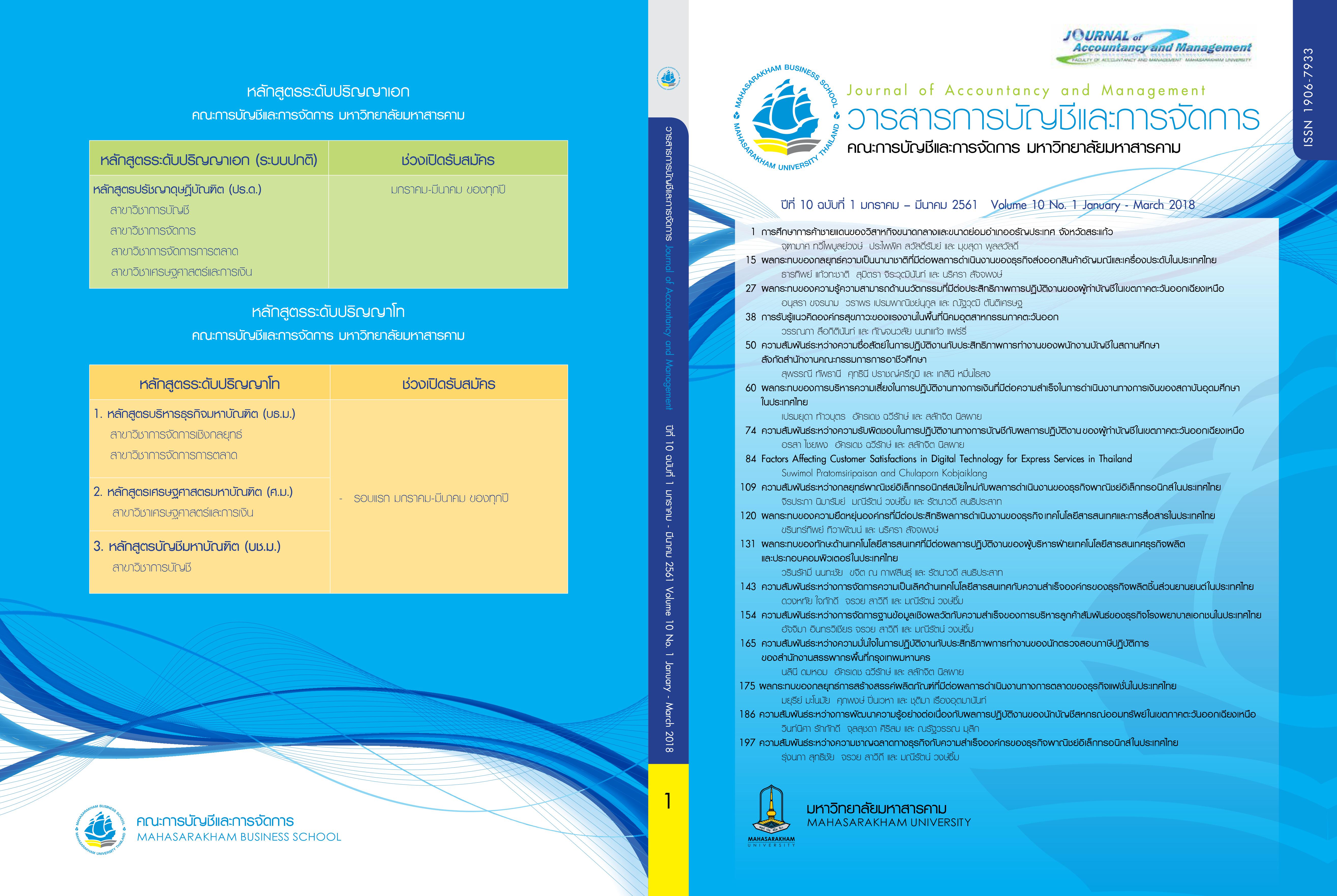ความสัมพันธ์ระหว่างการจัดการฐานข้อมูลเชิงพลวัตกับความสำเร็จของการบริหารลูกค้าสัมพันธ์ของธุรกิจโรงพยาบาลเอกชนในประเทศไทย
Main Article Content
บทคัดย่อ
การวิจัยครั้งนี้มีวัตถุประสงค์ เพื่อทดสอบความสัมพันธ์ระหว่างการจัดการฐานข้อมูลเชิงพลวัตกับความสำเร็จของการบริหารลูกค้าสัมพันธ์ของธุรกิจโรงพยาบาลเอกชนในประเทศไทย โดยใช้แบบสอบถามเป็นเครื่องมือในการเก็บรวบรวมข้อมูลข้อมูลจากผู้บริหารฝ่ายเทคโนโลยีสารสนเทศ ธุรกิจโรงพยาบาลเอกชนในประเทศไทย จำนวน 107 คน สถิติที่ใช้ในการวิเคราะห์ข้อมูล ได้แก่ การวิเคราะห์สหสัมพันธ์แบบพหุคูณ การวิเคราะห์การถดถอยอย่างง่าย และการวิเคราะห์การถดถอยแบบพหุคูณ ผลการวิจัยพบว่า พบว่า การจัดการฐานข้อมูลเชิงพลวัต ด้านการแปลและแสดงผลข้อมูล ด้านการกระจายข้อมูล และด้านการควบคุมข้อมูล มีความสัมพันธ์และผลกระทบเชิงบวกกับความสำเร็จของการบริหารลูกค้าสัมพันธ์ ดังนั้น ผู้บริหารฝ่ายเทคโนโลยีสารสนเทศธุรกิจโรงพยาบาลเอกชนในประเทศไทย ควรให้ความสำคัญเกี่ยวกับการแปลและการแสดงผลข้อมูลที่เหมาะสมกับการดำเนินงาน สามารถกระจายข้อมูลภายในธุรกิจได้อย่างรวดเร็ว พร้อมทั้งรักษาความปลอดภัยของข้อมูลและควบคุมความถูกต้องของข้อมูลเพื่อให้ข้อมูลภายในฐานข้อมูลมีความซ้ำซ้อนน้อยที่สุดและมีความอิสระต่อกัน โดยกลยุทธ์การจัดการฐานข้อมูลเชิงพลวัตนี้ จะส่งผลให้ผู้บริหารฝ่ายเทคโนโลยีสารสนเทศสามารถนำไปบริหารงานได้อย่างมีประสิทธิภาพต่อไป
Downloads
Article Details
บทความที่ได้รับการตีพิมพ์เป็นลิขสิทธิ์ของวารสารการบัญชีและการจัดการ
ข้อความที่ปรากฏในบทความแต่ละเรื่องในวารสารวิชาการเล่มนี้เป็นความคิดเห็นส่วนตัวของผู้เขียนแต่ละท่านไม่เกี่ยวข้องกับมหาวิทยาลัยมหาสารคาม และคณาจารย์ท่านอื่นๆในมหาวิทยาลัยฯ แต่อย่างใด ความรับผิดชอบองค์ประกอบทั้งหมดของบทความแต่ละเรื่องเป็นของผู้เขียนแต่ละท่าน หากมีความผิดพลาดใดๆ ผู้เขียนแต่ละท่านจะรับผิดชอบบทความของตนเองแต่ผู้เดียว
เอกสารอ้างอิง
กรมสนับสนุนบริการสุขภาพ กระทรวงสาธารณสุข. (2557). ข้อมูลโรงพยาบาลเอกชน. ค้นเมื่อ 21 สิงหาคม 2557, จาก www.hss.moph.go.th
ธิดาภา สิทธิ์อมรพร. (2556). การจัดการฐานข้อมูลสมัยใหม่ที่มีต่อความได้เปรียบด้านข้อสนเทศของธุรกิจ อสังหาริมทรัพย์ ในเขตภาคตะวันออกเฉียงเหนือในประเทศไทย. วิทยานิพนธ์ บธ.ม. มหาสารคาม : มหาวิทยาลัยมหาสารคาม.
ปราลี มณีรัตน์. (2552). การจัดการฐานข้อมูลธุรกิจ. กรุงเทพฯ : มหาวิทยาลัยศรีปทุม.
พงษ์ศักดิ์ ผกามาศ. (2553). ระบบไอซีทีและการจัดการยุคใหม่. กรุงเทพฯ : วี.ซี.พี.
พนาวัลย์ ชูศรีพัฒน์. (2554). ความสัมพันธ์ระหว่างกลยุทธ์การรักษาความสัมพันธ์ลูกค้ากับผลการดำเนินงานของธุรกิจประกันชีวิตในภาคตะวันออกเฉียงเหนือ. วิทยานิพนธ์ บธ.ม. มหาสารคาม : มหาวิทยาลัยมหาสารคาม.
ภานุ ลิมมานนท์. (2550). กลยุทธ์การบริหารลูกค้าสัมพันธ์ Customer Relationship Management (พิมพ์ครั้งที่ 3). กรุงเทพฯ : Secenaria I Asai.
วศิน เพิ่มทรัพย์ และวิโรจน์ ชัยมูล. (2548). ความรู้เบื้องต้นเกี่ยวกับคอมพิวเตอร์และเทคโนโลยีสารสนเทศ. กรุงเทพฯ : โปรวิชั่น.
วิภาพร วีรฤทธิชัย. (2549). ผลกระทบของการบริหารลูกค้าสัมพันธ์ต่อประสิทธิภาพการทำงานความพึงพอใจในการให้บริหารและผลการดำเนินงานของสำนักงานบัญชีในภาคตะวันออกเฉียงเหนือ. วิทยานิพนธ์ บช.ม. มหาสารคาม : มหาวิทยาลัยมหาสารคาม.
วิทยา ด่านธํารงกูล และพิภพ อุดร. (2549). ซีอาร์เอ็ม– ซีอาร์เอ็มหยินหยางการตลาด. กรุงเทพฯ : วงกลม .
ศูนย์ข้อมูลสารสนเทศ. (2558).การเปลี่ยนแปลงของระบบเทคโนโลยีสารสนเทศ. ค้นเมื่อ 2 มีนาคม 2558, จาก www.sitem.co.th
สมชาย จันทร์ศรีงาม. (2552). เทคโนโลยีสารสนเทศกับกลยุทธ์ธุรกิจ. ค้นเมื่อ 4 สิงหาคม 2552, จาก http://www.sirikitdam.egat.com/WEB_MIS/117/mis.htm
สมาคมโรงพยาบาลเอกชน. (2557). ประวัติและวัตถุประสงค์. ค้นเมื่อ 22 เมษายน 2557, จาก http://www.thaiph.org/body/purpose.html
โอภาส เอี่ยมสิริวงค์. (2555). การออกแบบและการจัดการฐานข้อมูล. กรุงเทพฯ : ซีเอ็ดยูเคชัน.
Aaker, D. A., Kumar, V., & Day, G. S. (2001). Marketing research (7thed.). New York : John Wiley & Sons.
Black, K. (2013). Business statistics for contemporary decision making. New York : John Wiley & Sons.
Nunnally, J. C., & Bernstein, I. H. (1994). Psychometric theory. New York : McGraw Hill.
Steiner, J. (2010). Oracle white paper information management with oracle database 11g Release 2. Redwood Shores, CA : U.S.A.


